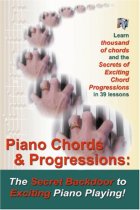The Most Pregnant Of All Altered 7th Chords
Altered 7th Chords
| Good morning. This is Duane, and we’ve been taking up all kinds of 7th chords. Today, is the end. I’m not going to go any further, but I just want to cover one more kind of 7th chord, before we move on to other subjects. We said a 7th chord, a dominant 7th chord, is a regular major triad, plus the flat 7th degree of the scale, not the 7th degree. If you see a chord symbol, say you’re reading from a fake book, or lead sheet, and it says C 7th, that’s what it means, it doesn’t mean that. If the arranger wants you to play B natural, he would say, “C Maj 7th,” because that’s a major 7th interval from C to B.
|
|
| If it just says C 7th, that’s what it means, the flat 7th. Then we said there’s such a thing as a minor 7th, which is just a minor triad, plus that same 7. Then there’s a diminished 7th, where we flat the 3rd and the 5th, but we double flat the 7th. It looks like the 6th, but we’ve got to call it B double flat in that case, that’s the diminished 7th. Yesterday, we took up the 7th with a flat 5. We said that’s a transition chord. Most 7th chords are transition chords, but that really wants to move.
|
|
| Today, I’d like to take up one more, and this is the most pregnant of all the altered 7th chords. It’s got to move. It’s going to deliver momentarily. What it is doing is imitating a half step slide. As you know, a half step slide is when you go from C … You know the C chord goes to F usually, okay? We’re going to do a half step slide, by sliding down from G flat to F. It’s like this. That’s a half step slide. We can make it sound a little bit more interesting if we do this kind of thing.
|
|
| It’s simply flat the 5th, and you flat the 9th. That’s what you’ll be playing, and your left hand has to play the root, of course, and it doesn’t hurt if you double the 7th. Now you see why that’s a half step slide, because three of those notes are simply this G flat chord upside down. It’s the second inversion of the G flat chord. Since it’s over C, it becomes part of the C 7th chord. Let me take it in context. I’m playing a long in the key of F.
|
|
| Some people call that a jazz chord. There’s really no such thing as jazz chord. Jazz pianist use complex chords, but they’re just made out of notes like any other kind of chord. Chances are some classical composer used it before some jazz pianist used it. In any case, that’s all you do to make a 7th chord to the flat 5th, and a flat 9th. That’s how you form it. I don’t think we need to go through all the twelve chords and form that, but just know that if you lower the 5th, and the 9th too, then you get that half step slide kind of feel.
|
|
| That’s it for today, tomorrow we’ll take up … We’re going to play a bunch of songs, and I’ll use various kinds of 7th chords in those songs so you can see them, and actually see the difference between those kinds of chords. We’ll see you tomorrow morning, same time, same station.
Click on this link to watch this video on YouTube: https://www.youtube.com/watch?v=lv4gkCEjAOc ***For lots more good stuff on piano playing come on over to my website at https://www.playpiano.com and sign up for our free piano tips – “Exciting Piano Chords & Sizzling Chord Progressions!” Here’s a great little book on chords and chord progressions on Amazon: http://www.amazon.com/Piano-Chords-Chord-Progressions-Exciting-ebook/dp/B0076OUGDE/ref=sr_1_1?s=books&ie=UTF8&qid=1404158669&sr=1-1&keywords=piano+chords+duane+shinn |




